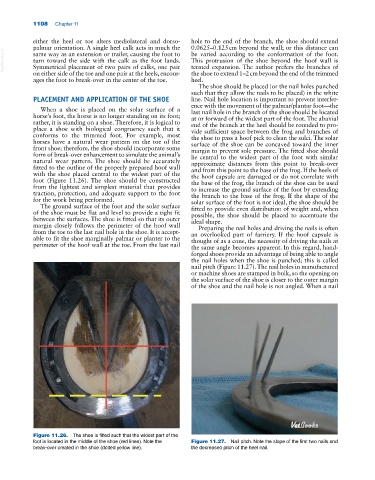Page 1142 - Adams and Stashak's Lameness in Horses, 7th Edition
P. 1142
1108 Chapter 11
either the heel or toe alters mediolateral and dorso hole to the end of the branch, the shoe should extend
palmar orientation. A single heel calk acts in much the 0.0625–0.125 cm beyond the wall; or this distance can
VetBooks.ir turn toward the side with the calk as the foot lands. This protrusion of the shoe beyond the hoof wall is
be varied according to the conformation of the foot.
same way as an extension or trailer, causing the foot to
termed expansion. The author prefers the branches of
Symmetrical placement of two pairs of calks, one pair
on either side of the toe and one pair at the heels, encour the shoe to extend 1–2 cm beyond the end of the trimmed
ages the foot to break‐over in the center of the toe. heel.
The shoe should be placed (or the nail holes punched
such that they allow the nails to be placed) in the white
PLACEMENT AND APPLICATION OF THE SHOE line. Nail hole location is important to prevent interfer
ence with the movement of the palmar/plantar foot—the
When a shoe is placed on the solar surface of a last nail hole in the branch of the shoe should be located
horse’s foot, the horse is no longer standing on its foot; at or forward of the widest part of the foot. The abaxial
rather, it is standing on a shoe. Therefore, it is logical to end of the branch at the heel should be rounded to pro
place a shoe with biological congruency such that it vide sufficient space between the frog and branches of
conforms to the trimmed foot. For example, most the shoe to pass a hoof pick to clean the sulci. The solar
horses have a natural wear pattern on the toe of the surface of the shoe can be concaved toward the inner
front shoe; therefore, the shoe should incorporate some margin to prevent sole pressure. The fitted shoe should
form of break‐over enhancement to simulate the animal’s lie central to the widest part of the foot with similar
natural wear pattern. The shoe should be accurately approximate distances from this point to break‐over
fitted to the outline of the properly prepared hoof wall and from this point to the base of the frog. If the heels of
with the shoe placed central to the widest part of the the hoof capsule are damaged or do not correlate with
foot (Figure 11.26). The shoe should be constructed the base of the frog, the branch of the shoe can be used
from the lightest and simplest material that provides to increase the ground surface of the foot by extending
traction, protection, and adequate support to the foot the branch to the base of the frog. If the shape of the
for the work being performed. solar surface of the foot is not ideal, the shoe should be
The ground surface of the foot and the solar surface fitted to provide even distribution of weight and, when
of the shoe must be flat and level to provide a tight fit possible, the shoe should be placed to accentuate the
between the surfaces. The shoe is fitted so that its outer ideal shape.
margin closely follows the perimeter of the hoof wall Preparing the nail holes and driving the nails is often
from the toe to the last nail hole in the shoe. It is accept an overlooked part of farriery. If the hoof capsule is
able to fit the shoe marginally palmar or planter to the thought of as a cone, the necessity of driving the nails at
perimeter of the hoof wall at the toe. From the last nail the same angle becomes apparent. In this regard, hand‐
forged shoes provide an advantage of being able to angle
the nail holes when the shoe is punched; this is called
nail pitch (Figure 11.27). The nail holes in manufactured
or machine shoes are stamped in bulk, so the opening on
the solar surface of the shoe is closer to the outer margin
of the shoe and the nail hole is not angled. When a nail
Figure 11.26. The shoe is fitted such that the widest part of the
foot is located in the middle of the shoe (red lines). Note the Figure 11.27. Nail pitch. Note the slope of the first two nails and
break‐over created in the shoe (dotted yellow line). the decreased pitch of the heel nail.

